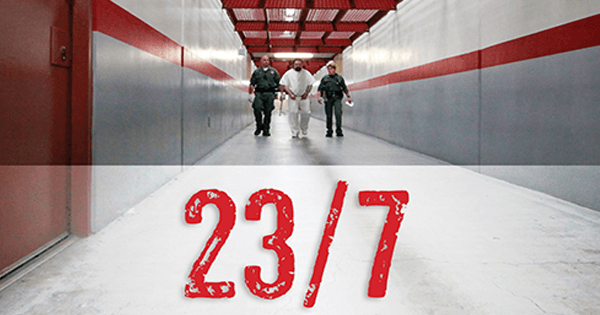23/7
Read an excerpt from Keramet Reiter’s new book about the rise of solitary confinement

This January, President Obama banned solitary confinement for juvenile offenders in federal prisons. But it’s still common practice to hold adults in isolation, in both federal and private prisons—and not just for hours or weeks, but for 23 hours out of every day, for years at a time. Keramet Reiter’s timely new book, 23/7: Pelican Bay Prison and the Rise of Long-Term Solitary Confinement, is the story of the “windowless concrete bunker” where “more than five hundred prisoners had lived in continuous isolation for more than ten years—a decade without a handshake or a hug.”
How did such isolation become routine in the United States, and who are the prisoners being held in supermax locations like “the Bay”? Read an excerpt from Reiter’s book, a “history of deprivation by design.”
Todd Ashker is muscular and ghostly pale. He has a thick chevron mustache and close-cropped hair. Intricate tattoos cover his torso and arms: an American eagle, the letter A, and more than one swastika. Behind and around the tattoos are plenty of scars—stab wounds, gunshot wounds, and other marks of a hardscrabble life. Most of these marks date to his early twenties; he has had virtually no human contact in the intervening three decades.
In 2015, Todd was fifty-two years old and had been in continuous solitary confinement for almost thirty years. He spends at least twenty-two hours of every day locked in a windowless concrete cell measuring eight by ten feet, roughly the size of a wheelchair-accessible bathroom stall. Fluorescent lights remain on all day, every day. Prison slang for this kind of isolation cell captures the visceral experience of the place: the “box,” the “hole,” the “SHU” (an acronym for the official correctional label Security Housing Unit, which is pronounced “shoe”), and “zapato” (the Spanish word for “shoe”). Todd’s box, like the 1,055 other isolation boxes at California’s Pelican Bay State Prison, has only three furniture-like components: a concrete ledge with a slim foam pad, which serves as a bed; a solid-steel sink-toilet combination fixture; and two cement cubes jutting from the wall, forming an awkward chair and desk of sorts. As long as he follows prison rules precisely and can afford to buy the items, Todd is permitted a small television or radio, ten books or magazines, and one legal pad. Almost everything else is forbidden. Even clocks are not allowed.
While in this box, Todd has written complaints to initiate fifteen lawsuits, learned of his mother’s death, been shot at, and (with ten other prisoners) led multiple hunger strikes—one with thirty thousand prisoner participants. This activity makes life in the box sound more exciting than it is.
The boundless reality is minutes, hours, days, weeks, and months spent sealed inside a concrete cube filled with stale air and fluorescent light. One former prisoner, who had spent just one month in a Pelican Bay cell like the one where Todd has lived for almost three decades, suggested that if I wanted to understand life in the box, I should try staying locked in my bathroom for a week. A correspondent of Todd’s, the sociology professor Denis O’Hearn, suggested a similar experiment: “Sit in a closet for an hour. Put a metal screen over the doorway that you can barely see through. Now think about sitting there for twenty-five years, communicating only with strangers in nearby closets by shouting out the door . . . This is Todd Ashker’s life.”
I was disinclined to try it. How could a day or a week compare to three decades? Todd’s day-to-day existence is almost impossible to imagine. Easier to imagine: what manner of terrible things must he have done to deserve being “buried alive” in isolation for so long? Media accounts have described him as “sociopathic,” “the worst of the worst,” and “a convicted murderer with alleged Aryan Brotherhood ties.”
But when Todd first entered the box, in 1986, he was none of those things. He was twenty-three and had been in and out of juvenile detention facilities and foster care for years. He had already served one adult “bid,” or prison term, for burglary. In prison at nineteen, he got his first swastika tattoo—“white pride” and “juvenile thrill,” he later called it. After he finished that first bid, he stayed out of prison for just four months before being rearrested for burglary and assault in January 1985. Sentenced to six years in prison, he started serving time on this second bid at Folsom State Prison. Meanwhile, Todd’s father, Lewis Ashker, murdered a retired police officer in a botched attempt to steal the man’s gun collection. Lewis was sentenced to life in prison in South Dakota.
In prison on his second bid, with his father incarcerated for life, Todd seemed bound for a life of crime. Over the next two years, he stabbed a prisoner to death, was implicated in the stabbing of a civilian, was “validated” by prison officials as a member of a murderous prison gang, earned a life sentence, and was assigned to an indeterminate term in isolation. Each event brought him one step closer to the Pelican Bay SHU.
Excerpted from 23/7: Pelican Bay Prison and the Rise of Long-Term Solitary Confinement by Keramet Reiter, published by Yale University Press. Reprinted by permission. All rights reserved.

